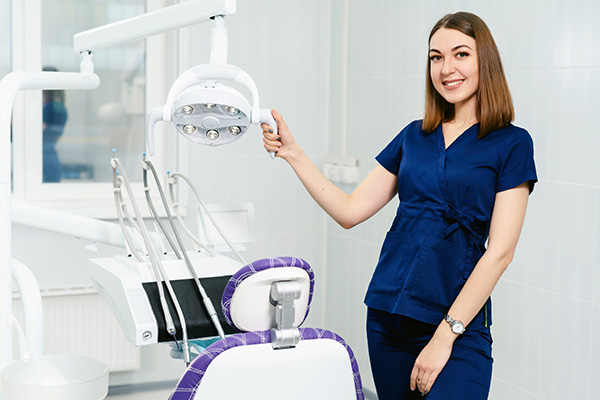Need Gum Surgery? Here’s Why Laser Dentistry Is a Popular Option

Laser dentistry provides a non-invasive alternative to traditional gum surgery. Periodontal disease is caused by bacteria and tartar infecting tissues underneath the gums. The infection leads to inflammation in the gums as the person's immune system battles the infection. The end result is damage to the tissues and structures that support teeth.
Gum disease has two main stages. The first stage is called gingivitis, and it can typically be reversed with good oral hygiene, daily flossing and regular cleanings performed by a dentist. When left untreated, gingivitis will progress to periodontal disease, which causes gum tissues to pull back from tooth surfaces and create spaces called gum pockets. During the advanced stages of periodontal disease, these pockets become filled with pus, leading to more inflammation around the base of the teeth. The advanced stages of periodontal disease lead to a weakening of the ligaments that hold teeth in place, bone loss in the jaw and teeth becoming loose.
When periodontal disease leads to teeth becoming loose, a dentist might decide to extract the tooth to prevent the infection from spreading further. Periodontal disease cannot be reversed and quick treatment is needed in order to limit the damage done to tooth structures.
How laser dentistry prevents the need for gum flap surgery
One of the treatments used to address periodontal disease is gum flap surgery. It is an effective way to treat the infection underneath the gums, but it requires the dentist to pull the patient's gums back so that they can use dental tools like scalers to clean tooth roots and gum pockets.
Anesthetics are used when performing gum flap surgery. This prevents pain and discomfort during the procedure, but patients typically experience soreness afterward as their gums heal and reattach themselves to tooth surfaces. The recovery period after gum flap surgery can be as long as two weeks.
Laser periodontal disease treatments
Laser treatments for gum disease have been around for almost two decades and they are a less invasive way to treat infections underneath the gums. It often leads to minimal side effects, and there is a lower risk of infection. This is a huge benefit for people with deficient immune systems as they are more likely to develop infections after surgical procedures.
Using a dental laser to treat an infection allows the dentist to remove bacteria and diseased tissues without damaging healthy tissues and structures. During laser treatments for gum disease, the dentist uses the laser to clean gum pockets and to compress gum tissues against tooth roots.
People who opt for laser gum treatments typically experience less soreness and discomfort after their treatment. Laser treatments can also be used to encourage the regeneration of the bone structures that support teeth.
Give laser gum treatments a try
Want to avoid having to deal with sore and painful gums after gum flap surgery? Contact our Chester clinic to learn more about how lasers provide a less invasive way to treat periodontal disease.
Request an appointment here: https://thechesterfielddentist.com or call Chesterfield Dentist at (804) 412-0867 for an appointment in our Chester office.
Check out what others are saying about our services on Yelp: Read our Yelp reviews.
Recent Posts
Sleep apnea is a serious sleep disorder that affects millions of individuals worldwide. It occurs when breathing repeatedly stops and starts during sleep, disrupting rest and potentially causing long-term health consequences. Many people are unaware that a general dentist plays a key role in diagnosing and managing sleep apnea, particularly with non-invasive treatment solutions. By…
Dental restorations can improve overall health by decreasing the chances of infection, decay, and issues caused by broken or misaligned teeth. These treatments range from removing teeth, replacing tooth structures that have decayed, and correcting the patient’s overall bite to improving eating and drinking.A restoration may be performed for cosmetic or health-related reasons, but even…
Crowns are commonly used in dental restorations. A crown is a cap shaped like a tooth but hollow in the middle. It fits over a natural tooth that has to be prepared first. Depending on the issue it is correcting, a crown can be used by itself or as a component of another restoration technique.Teeth…
A broken tooth can affect both oral health and confidence. Whether caused by biting into something hard, an accident, or underlying decay, prompt dental care is essential to prevent further damage and restore normal function. Fortunately, modern dentistry provides several reliable treatments that repair structural damage and rebuild a natural-looking smile. A cosmetic, family, or…


